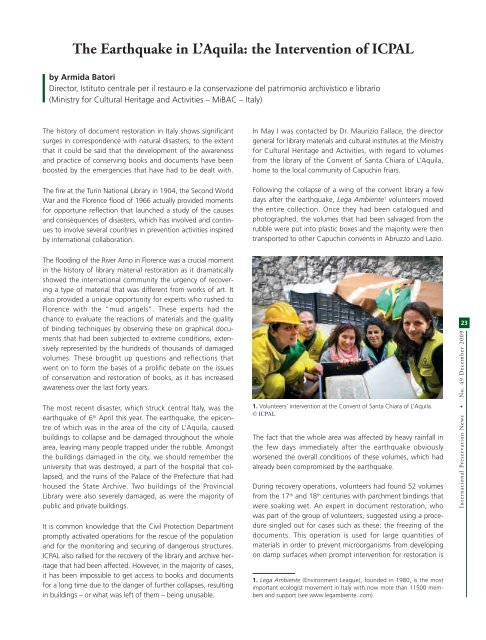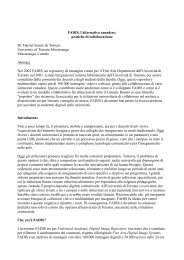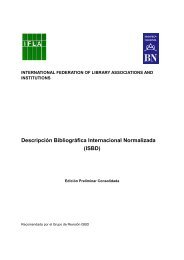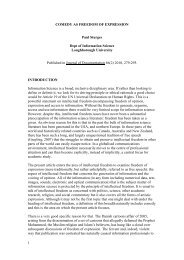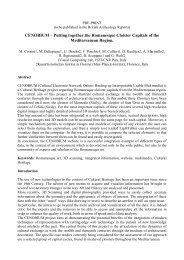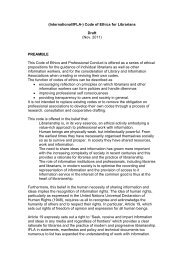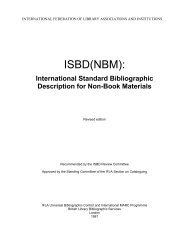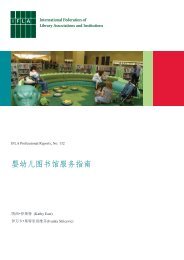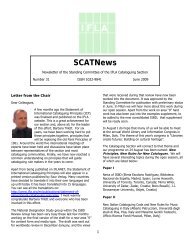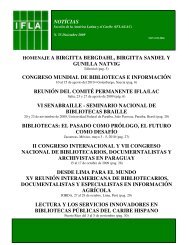No 49 - IFLA
No 49 - IFLA
No 49 - IFLA
You also want an ePaper? Increase the reach of your titles
YUMPU automatically turns print PDFs into web optimized ePapers that Google loves.
The Earthquake in L’Aquila: the Intervention of ICPAL<br />
by Armida Batori<br />
Director, Istituto centrale per il restauro e la conservazione del patrimonio archivistico e librario<br />
(Ministry for Cultural Heritage and Activities – MiBAC – Italy)<br />
The history of document restoration in Italy shows significant<br />
surges in correspondence with natural disasters, to the extent<br />
that it could be said that the development of the awareness<br />
and practice of conserving books and documents have been<br />
boosted by the emergencies that have had to be dealt with.<br />
The fire at the Turin National Library in 1904, the Second World<br />
War and the Florence flood of 1966 actually provided moments<br />
for opportune reflection that launched a study of the causes<br />
and consequences of disasters, which has involved and continues<br />
to involve several countries in prevention activities inspired<br />
by international collaboration.<br />
The flooding of the River Arno in Florence was a crucial moment<br />
in the history of library material restoration as it dramatically<br />
showed the international community the urgency of recovering<br />
a type of material that was different from works of art. It<br />
also provided a unique opportunity for experts who rushed to<br />
Florence with the “mud angels”. These experts had the<br />
chance to evaluate the reactions of materials and the quality<br />
of binding techniques by observing these on graphical documents<br />
that had been subjected to extreme conditions, extensively<br />
represented by the hundreds of thousands of damaged<br />
volumes. These brought up questions and reflections that<br />
went on to form the bases of a prolific debate on the issues<br />
of conservation and restoration of books, as it has increased<br />
awareness over the last forty years.<br />
The most recent disaster, which struck central Italy, was the<br />
earthquake of 6 th April this year. The earthquake, the epicentre<br />
of which was in the area of the city of L’Aquila, caused<br />
buildings to collapse and be damaged throughout the whole<br />
area, leaving many people trapped under the rubble. Amongst<br />
the buildings damaged in the city, we should remember the<br />
university that was destroyed, a part of the hospital that collapsed,<br />
and the ruins of the Palace of the Prefecture that had<br />
housed the State Archive. Two buildings of the Provincial<br />
Library were also severely damaged, as were the majority of<br />
public and private buildings.<br />
It is common knowledge that the Civil Protection Department<br />
promptly activated operations for the rescue of the population<br />
and for the monitoring and securing of dangerous structures.<br />
ICPAL also rallied for the recovery of the library and archive heritage<br />
that had been affected. However, in the majority of cases,<br />
it has been impossible to get access to books and documents<br />
for a long time due to the danger of further collapses, resulting<br />
in buildings – or what was left of them – being unusable.<br />
In May I was contacted by Dr. Maurizio Fallace, the director<br />
general for library materials and cultural institutes at the Ministry<br />
for Cultural Heritage and Activities, with regard to volumes<br />
from the library of the Convent of Santa Chiara of L’Aquila,<br />
home to the local community of Capuchin friars.<br />
Following the collapse of a wing of the convent library a few<br />
days after the earthquake, Lega Ambiente 1 volunteers moved<br />
the entire collection. Once they had been catalogued and<br />
photographed, the volumes that had been salvaged from the<br />
rubble were put into plastic boxes and the majority were then<br />
transported to other Capuchin convents in Abruzzo and Lazio.<br />
1. Volunteers’ intervention at the Convent of Santa Chiara of L’Aquila.<br />
© ICPAL<br />
The fact that the whole area was affected by heavy rainfall in<br />
the few days immediately after the earthquake obviously<br />
worsened the overall conditions of these volumes, which had<br />
already been compromised by the earthquake.<br />
During recovery operations, volunteers had found 52 volumes<br />
from the 17 th and 18 th centuries with parchment bindings that<br />
were soaking wet. An expert in document restoration, who<br />
was part of the group of volunteers, suggested using a procedure<br />
singled out for cases such as these: the freezing of the<br />
documents. This operation is used for large quantities of<br />
materials in order to prevent microorganisms from developing<br />
on damp surfaces when prompt intervention for restoration is<br />
1. Lega Ambiente (Environment League), founded in 1980, is the most<br />
important ecologist movement in Italy with now more than 11500 members<br />
and support (see www.legambiente..com).<br />
23<br />
International Preservation News <strong>No</strong>. <strong>49</strong> December 2009


